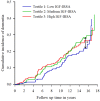Revisiting the Role of Insulin-Like Growth Factor-I Receptor Stimulating Activity and the Apolipoprotein E in Alzheimer's Disease
- PMID: 30809143
- PMCID: PMC6380107
- DOI: 10.3389/fnagi.2019.00020
Revisiting the Role of Insulin-Like Growth Factor-I Receptor Stimulating Activity and the Apolipoprotein E in Alzheimer's Disease
Abstract
Background: Alterations in insulin-like growth factor I (IGF-I) signaling have been associated with dementia and Alzheimer's disease (AD). Studies on the association between IGF-I levels and dementia risk have been inconclusive. We reported earlier that higher levels of IGF-I receptor stimulating activity are associated with a higher prevalence and incidence of dementia. Objective: In the present study, we test the robustness of the association between IGF-I receptor stimulating activity and dementia by extending the follow-up period to 16 years and investigate possible effect modification by apolipoprotein E (ApoE). Methods: At baseline, circulating IGF-I receptor stimulating activity was determined by the IGF-I kinase receptor activation (KIRA) assay in 1,014 elderly from the Rotterdam Study. Dementia was assessed from baseline (1997-1999) to follow-up in January 2015. Associations of IGF-I receptor stimulating activity and incident dementia were assessed with Cox proportional hazards models. Results: During 10,752 person-years of follow-up, 174 people developed dementia. In the extended follow-up we no longer observed a dose-response relationship between IGF-I receptor stimulating activity and risk of dementia [adjusted odds ratio 1.11; 95% confidence interval (CI) 0.97-1.28]. Interestingly, we found evidence of an interaction between ApoE-ε4 and tertiles of IGF-I receptor stimulating activity. IGF-I receptor stimulating activity in the median and top tertiles was related to increased dementia incidence in hetero- and homozygotes of the ApoE-ε4 allele, but did not show any association with dementia risk in people without the ApoE-ε4 allele (adjusted odds ratio medium vs. low IGF-I receptor stimulating activity in ApoE-ε4 carriers: 1.45; 95% CI 1.00-2.12). These findings suggest a threshold effect in ApoE-ε4 carriers. In line with the hypothesis that downregulation of IGF-I signaling is associated with increased dementia risk, ApoE-ε4 homozygotes without prevalent dementia displayed lower levels of IGF-I receptor stimulating activity than heterozygotes and non-carriers. Conclusion: The findings shed new light on the association between IGF-I signaling and the neuropathology of dementia and ask for replication in other cohorts, using measures of IGF-I receptor stimulating activity rather than total serum levels as putative markers of dementia risk.
Keywords: Alzheimer’s disease; KIRA assay; apolipoprotein E; dementia; genetic epidemiology; insulin-like growth factor I.
Figures


Similar articles
-
Insulin-like growth factor-I receptor stimulating activity is associated with dementia.J Alzheimers Dis. 2014;42(1):137-42. doi: 10.3233/JAD-140186. J Alzheimers Dis. 2014. PMID: 24820016
-
The effect of APOE and other common genetic variants on the onset of Alzheimer's disease and dementia: a community-based cohort study.Lancet Neurol. 2018 May;17(5):434-444. doi: 10.1016/S1474-4422(18)30053-X. Epub 2018 Mar 16. Lancet Neurol. 2018. PMID: 29555425
-
Apolipoprotein E epsilon4 association with dementia in a population-based study: The Framingham study.Neurology. 1996 Mar;46(3):673-7. doi: 10.1212/wnl.46.3.673. Neurology. 1996. PMID: 8618665
-
Apolipoprotein E epsilon 4 genotype and a physically active lifestyle in late life: analysis of gene-environment interaction for the risk of dementia and Alzheimer's disease dementia.Psychol Med. 2014 Apr;44(6):1319-29. doi: 10.1017/S0033291713001918. Epub 2013 Jul 24. Psychol Med. 2014. PMID: 23883793
-
Overwhelming Evidence for a Major Role for Herpes Simplex Virus Type 1 (HSV1) in Alzheimer's Disease (AD); Underwhelming Evidence against.Vaccines (Basel). 2021 Jun 21;9(6):679. doi: 10.3390/vaccines9060679. Vaccines (Basel). 2021. PMID: 34205498 Free PMC article. Review.
Cited by
-
Hypoglycemia, Vascular Disease and Cognitive Dysfunction in Diabetes: Insights from Text Mining-Based Reconstruction and Bioinformatics Analysis of the Gene Networks.Int J Mol Sci. 2021 Nov 17;22(22):12419. doi: 10.3390/ijms222212419. Int J Mol Sci. 2021. PMID: 34830301 Free PMC article.
-
Insulin-like Growth Factor 1 Impact on Alzheimer's Disease: Role in Inflammation, Stress, and Cognition.Curr Issues Mol Biol. 2025 Mar 27;47(4):233. doi: 10.3390/cimb47040233. Curr Issues Mol Biol. 2025. PMID: 40699632 Free PMC article. Review.
-
The Other Side of Alzheimer's Disease: Influence of Metabolic Disorder Features for Novel Diagnostic Biomarkers.J Pers Med. 2020 Sep 6;10(3):115. doi: 10.3390/jpm10030115. J Pers Med. 2020. PMID: 32899957 Free PMC article. Review.
-
Integrated DNA Methylation/RNA Profiling in Middle Temporal Gyrus of Alzheimer's Disease.Cell Mol Neurobiol. 2023 Jul;43(5):2289-2307. doi: 10.1007/s10571-022-01307-3. Epub 2023 Jan 3. Cell Mol Neurobiol. 2023. PMID: 36596913 Free PMC article.
-
Circulating IGFBP-2: a novel biomarker for incident dementia.Ann Clin Transl Neurol. 2019 Sep;6(9):1659-1670. doi: 10.1002/acn3.50854. Epub 2019 Aug 2. Ann Clin Transl Neurol. 2019. PMID: 31373442 Free PMC article.
References
-
- Aguado-Llera D., Arilla-Ferreiro E., Campos-Barros A., Puebla-Jiménez L., Barrios V. (2005). Protective effects of insulin-like growth factor-I on the somatostatinergic system in the temporal cortex of β-amyloid-treated rats. J. Neurochem. 92, 607–615. 10.1111/j.1471-4159.2004.02889.x - DOI - PubMed
-
- American Psychiatric Association. American Psychiatric Association. Work Group to Revise DSM-III (1987). Diagnostic and Statistical Manual of Mental Disorders: DSM-III-R. Washington, DC: American Psychiatric Association.
-
- Brugts M. P., Ranke M. B., Hofland L. J., van der Wansem K., Weber K., Frystyk J., et al. . (2008). Normal values of circulating insulin-like growth factor-I bioactivity in the healthy population: comparison with five widely used IGF-I immunoassays. J. Clin. Endocrinol. Metab. 93, 2539–2545. 10.1210/jc.2007-2454 - DOI - PubMed
LinkOut - more resources
Full Text Sources
Miscellaneous

